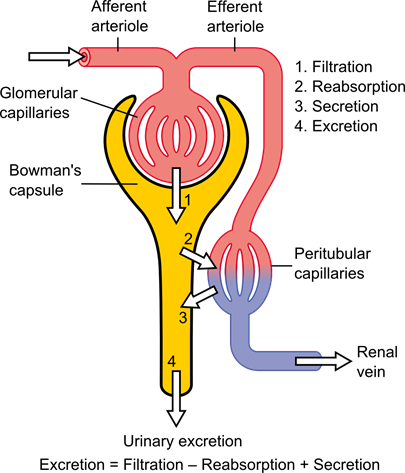
PUMPA - SMART LEARNING
எங்கள் ஆசிரியர்களுடன் 1-ஆன்-1 ஆலோசனை நேரத்தைப் பெறுங்கள். டாப்பர் ஆவதற்கு நாங்கள் பயிற்சி அளிப்போம்
Book Free DemoHow is urine produced in the kidneys?
Waste is excreted primarily in the form of urine in human. Urine is produced to filter the waste products from the blood. The nitrogenous metabolic wastes such as urea or uric acid are removed from the blood in the kidneys. The nephrons help in the filtration of these wastes from the blood.
The urine composition includes approximately 95 \% water and 5\% solid wastes. Urine formation includes three steps:
1. Glomerular filtration
2. Tubular reabsorption
3. Secretion

Urine formation
1. Glomerular filtration
Glomerular filtration is the primary step in urine production which takes place in the glomerulus. The process of filtration takes place in three layers, namely:
- Endothelium of glomerulus
- Epithelium of Bowman's capsule
- Basement membrane between the two layers
Blood containing wastes along with fluids are filtered in the glomerulus. Blood that is filtered out from the glomerulus enters the Bowman's capsule. The filtrate is called glomerular filtrate.
2. Tubular reabsorption
The glomerular filtrate and blood plasma are similar, but the filtrate does not have plasma proteins. The renal tubules reabsorb almost 99\% of the filtrate. This is called reabsorption.
The absorption of filtrate is carried out through active and passive transport. Absorption of ions like Na^+, molecules like glucose, amino acids and water occurs here. The amount of water reabsorbed depends on the excess water present in the body.
3. Secretion
Tubular secretion is a vital step in the production of urine as it aids in the maintenance of the ionic and acid-base balance of the fluids present in the body. There is secretion of H^+, K^+ and ammonia into the filtrate.
Thus, we can see that the filtrate formed combines with the secreted ion to form urine. The urine passes from the nephron to the collecting duct. From the collecting duct, it reaches the urinary bladder through the ureter.
Urine is stored in the bladder until the bladder pressure leads to the urge to pass the urine through the urethra. Then, the bladder sends signals to the CNS, which allows the relaxation of the sphincter muscles to release urine.
Artificial kidney or Hemodialysis
Kidneys are the vital organs for the survival of an organism. However, infections, injury, restricted blood flow to kidneys reduces the activity of kidneys. This causes the accumulation of harmful metabolic wastes.
If the wastes are not removed, it may potentially lead to kidney failure and ultimately todeath. To overcome kidney failure, an artificial kidney can thus be used.
An artificial kidney is a device that performs a similar function to that of the kidney. It removes nitrogenous waste products from the blood through the process of dialysis.
Artificial kidneys are made up of a series of semi-permeable tubes suspended in a tank of dialysing fluid. The dialysing fluid has the same osmotic pressure as blood, except that it does not contain nitrogenous wastes.
The blood of the patient is pumped through these tubes. The nitrogenous waste materials diffuse into the dialysing fluid when the blood is circulated in the fluid. The purified blood is then reintroduced into the patient. Thus, the artificial kidney function is comparable to that of the kidney, but it differs in that it does not involve reabsorption.

Haemodialysis
Normally, on average, the initial filtrate in the kidneys is around 180 litres per day. However, the volume that is excreted is only one or two litres per day. Therefore, the renal tubules of the kidney reabsorb the remaining filtrate.
What is meant by organ donation?
Organ donation is donating an organ to a person who is suffering from organ failure(s).
When is transplantation required?
Transplantation is required when the recipient's organ has been damaged or failed due to disease or injury. In organ transplantation, the organ from the organ donor is surgically removed and transferred to the recipient. Corneas, heart, kidneys, liver, lungs, pancreas, and bone marrow are among the most commonly transplanted organs.
The majority of organ and tissue donations occur just after the donorpasses away or when a person is declared brain dead by a doctor. However, some organs and tissues, such as a kidney, a portion of a liver, a lung etc., can be donated while the donor is still alive.

Reference:
https://commons.wikimedia.org/wiki/File:Physiology_of_Nephron.png
https://www.shutterstock.com/image-vector/vector-illustration-hemodialysis-device-1041118672
https://commons.wikimedia.org/wiki/File:Kidney_Transplant.png